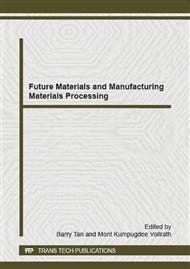p.45
p.53
p.63
p.71
p.77
p.83
p.89
p.97
p.103
Research on the Impact of Increase Pressure on the Homogeneity of the Cast in Die Casting Technology
Abstract:
The production of die castings cast into a metal mold has in recent years achieved an expansive growth in the volume as well as the range of production and that is particularly in aviation and automobile industry. In the process of die casting the final quality of a cast is influenced by a great number of factors. The main factors of die casting are: pressing velocity, increase pressure, the melt temperature and the mold temperature. A primary criterion for achieving reliability, efficiency and quality of production is to ensure minimization of the castings defects occurrence in castings correct setting technological factors of die casting. The presented paper deals with the experimental assessment of the impact of increase pressure on the mechanical properties and homogeneity of a die cast.
Info:
Periodical:
Pages:
77-82
Citation:
Online since:
February 2015
Authors:
Keywords:
Price:
Сopyright:
© 2015 Trans Tech Publications Ltd. All Rights Reserved
Share:
Citation:


